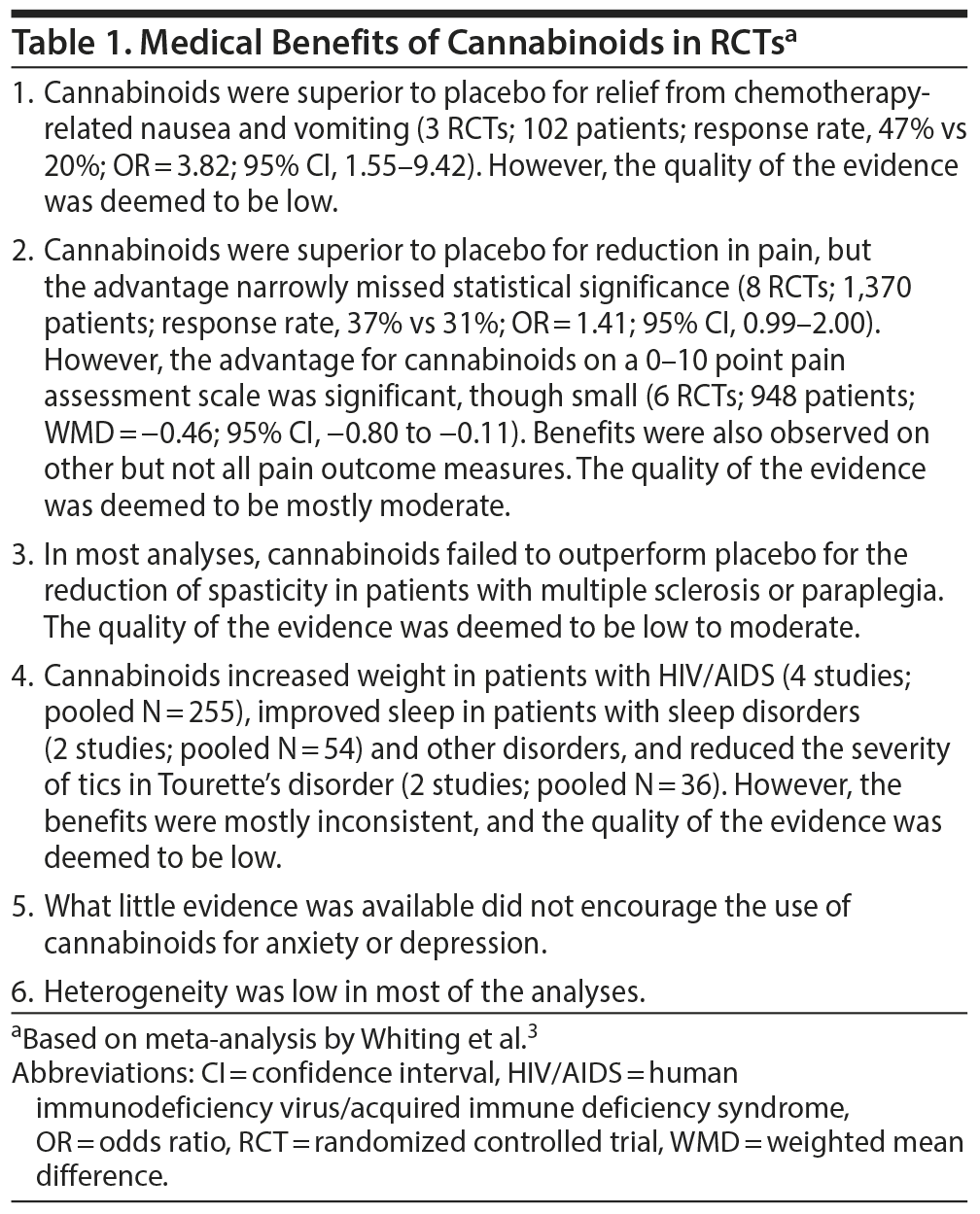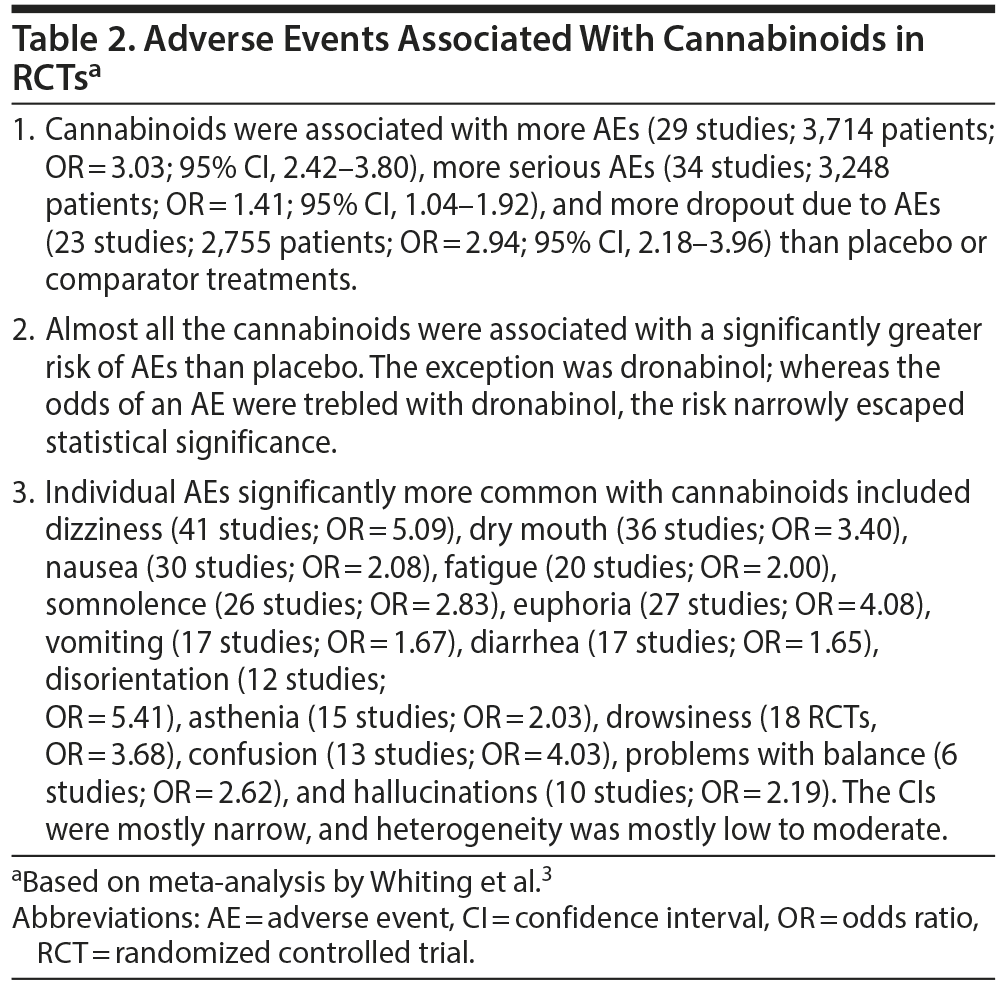Cannabis is popularly believed to be a relatively benign substance. Cannabis is also considered to have potential medical benefits, and medical marijuana has been legislated in many parts of the world. However, a recent meta-analysis found that cannabinoids were associated with only modest benefits for chemotherapy-related nausea and vomiting, small and inconsistent benefits for pain and spasticity, and inconclusive benefits for other indications such as improvement of appetite and weight, reduction in tic severity, and improvement of mood or sleep. On the flip side, cannabinoids and cannabis have acute and long-term adverse effects. In randomized controlled trials, cannabinoids increase the risk of total adverse events, serious adverse events, and dropout due to adverse events. Cannabis impairs cognition, and driving after cannabis use is associated with an increased risk of traffic accidents, including fatal accidents. Long-term cannabis use may lead to dependence, respiratory conditions, psychosis, and possibly cancer, as well. Cannabis use during pregnancy may compromise certain pregnancy outcomes such as fetal growth, and use during adolescence may compromise neurodevelopment, social adjustment, and vocational success. The composition and bioavailability of cannabis vary across preparations of the substance and routes of administration; this limits the ability to generalize the findings of studies. The findings of older research may no longer apply to current strains of cannabis that are higher in psychotogenic content. It is important for medical professionals and the lay public to understand the limitations of the efficacy data and the seriousness of the risks associated with cannabis use in medical and recreational contexts.

- Relative to placebo, cannabinoids are associated with only modest benefits for chemotherapy-related nausea and vomiting, small and inconsistent benefits for pain and spasticity, and inconclusive benefits for other indications.
- In randomized controlled trials, cannabinoids increase the risk of total adverse events, serious adverse events, and dropout due to adverse events. Cannabinoids also increase the risk of a large number of specific adverse events.
- Cannabis use is associated with a range of short- and long-term adverse consequences, including impaired cognition, traffic accidents, dependence, respiratory conditions, psychosis, and possibly cancer. Use in adolescence may have adverse implications for psychosocial adjustment and vocational success.
- Current strains of street cannabis may have higher potency and may hence carry higher risks than strains evaluated in former research.

ABSTRACT
Cannabis is popularly believed to be a relatively benign substance. Cannabis is also considered to have potential medical benefits, and medical marijuana has been legislated in many parts of the world. However, a recent meta-analysis found that cannabinoids were associated with only modest benefits for chemotherapy-related nausea and vomiting, small and inconsistent benefits for pain and spasticity, and inconclusive benefits for other indications such as improvement of appetite and weight, reduction in tic severity, and improvement of mood or sleep. On the flip side, cannabinoids and cannabis have acute and long-term adverse effects. In randomized controlled trials, cannabinoids increase the risk of total adverse events, serious adverse events, and dropout due to adverse events. Cannabis impairs cognition, and driving after cannabis use is associated with an increased risk of traffic accidents, including fatal accidents. Long-term cannabis use may lead to dependence, respiratory conditions, psychosis, and possibly cancer, as well. Cannabis use during pregnancy may compromise certain pregnancy outcomes such as fetal growth, and use during adolescence may compromise neurodevelopment, social adjustment, and vocational success. The composition and bioavailability of cannabis vary across preparations of the substance and routes of administration; this limits the ability to generalize the findings of studies. The findings of older research may no longer apply to current strains of cannabis that are higher in psychotogenic content. It is important for medical professionals and the lay public to understand the limitations of the efficacy data and the seriousness of the risks associated with cannabis use in medical and recreational contexts.
J Clin Psychiatry 2016;77(5):e551-e554
dx.doi.org/10.4088/JCP.16f10841
© Copyright 2016 Physicians Postgraduate Press, Inc.
Introduction
Cannabis is an illegal substance in most countries. Nevertheless, it is so widely used recreationally that it may be the most commonly used illicit drug in the world.1 There is a popular belief that cannabis use is benign, or at least less harmful than the use of socially sanctioned and legal substances such as alcohol. There is also some belief that cannabis use may benefit patients such as those who suffer from chronic pain or spasticity that does not respond to conventional treatments. This article puts together recent data on the medical benefits and short- and long-term risks associated with cannabis and cannabinoids; the effect of cannabis use on the risk of psychosis will be examined in a subsequent article in this column.
The Medical Benefits of Cannabinoids
The District of Columbia and 23 of the 50 US states have legislated medical marijuana, with the actual laws varying from state to state.2 Medical marijuana is also available in Canada and the Netherlands. In this context, Whiting et al3 described a systematic review and meta-analysis of the efficacy of cannabinoids in different medical contexts.
A search of electronic databases and other sources identified 79 relevant randomized controlled trials (RCTs) on the use of cannabinoids for medical indications. Most of the RCTs were for chemotherapy-related nausea and vomiting (28 studies; pooled n = 1,772), chronic pain of various etiologies (28 studies; pooled n = 2,454), or spasticity (14 studies; pooled n = 2,280). Most of these studies evaluated nabiximols (19 studies), nabilone (20 studies), or dronabinol (13 studies); only 2 studies evaluated cannabis. Most of the studies were placebo-controlled; the rest employed a variety of active controls. Only 34 trials were parallel-group studies; the rest were crossover studies. Only 4 RCTs were considered to be at low risk of bias; principal sources of bias related to incomplete outcome data, especially with regard to study withdrawals. The pooled sample included 6,462 patients. Because studies were widely heterogenous in clinical characteristics, only some were appropriate for the efficacy analyses; the rest contributed to the adverse effects analyses.
Important efficacy outcomes from the meta-analysis are presented in Table 1. In summary, all comparisons were against placebo, and cannabinoids were not a magic bullet for any indication. Cannabinoids were associated with modest benefits for chemotherapy-related nausea and vomiting, but only small and inconsistent benefits for pain and spasticity. Other benefits, such as for improving appetite and weight in specified conditions, reducing tic severity, and facilitating sleep seemed possible, but the data were not sufficient in terms of quality or consistency for firm conclusions to be drawn.3
Cannabis and Global Burden of Disease
Data from the Global Burden of Disease Study 2010 suggested that, during 2010, an estimated 13.1 million persons were dependent on cannabis; the point prevalence was 0.19%. The prevalence was higher in high-income regions, peaked in the 20- to 24-year age band, and was nearly twice as high in males as in females. Cannabis dependence was associated with 2,057,000 years of life lived with disability and the same number of disability-adjusted life-years.4,5 In Canada, these statistics were estimated to be 10,533 years of life lost due to premature mortality, 55,813 years of life lost due to disability, 66,346 disability-adjusted life-years, and 287 deaths in 2012.6
Cannabis use is associated with short- and long-term adverse consequences. These are discussed in subsequent sections.
Short-Term Risks Associated With Cannabis and Cannabinoid Use
Adverse effects of cannabinoids. In the meta-analysis that they described, Whiting et al3 also examined adverse outcomes associated with cannabinoid treatments. These are presented in Table 2. In summary, the RCT data showed that cannabinoids were associated with a significant adverse effect burden, including the risk of serious adverse events. There were many specific adverse events the risks of which were significantly increased; confidence intervals were mostly narrow, indicating high precision of estimates, and heterogeneity across RCTs was mostly low to moderate, indicating that the findings were similar across studies.
Cannabis use and impaired cognition. Cannabis use has long been suggested to adversely affect cognition. A systematic review7 concluded that verbal learning and memory and attention are functions that are most consistently impaired by acute and chronic cannabis use. Psychomotor impairment occurs most obviously during acute intoxication but may be detected in chronic users, as well. The neuropsychological deficits probably arise from impairments that have been identified in hippocampal, prefrontal, subcortical, and other brain networks that subserve cognition.8
Cannabis use and the risk of motor vehicle accidents. A systematic review and meta-analysis of 9 studies (pooled N = 49,411) showed that driving after cannabis use was associated with a doubled risk of motor vehicle accidents (OR = 1.92; 95% CI, 1.35-2.73), especially fatal accidents (OR = 2.10; 95% CI, 1.31-3.36). In studies that assessed cannabis use combined with alcohol, the risk estimate was higher with combined use relative to cannabis use alone, suggesting additive or synergistic adverse psychomotor effects.9 Neither the meta-analysis nor the studies on which it was based establish causality. This is because confounding could arise from many sources. As an example, it is possible that personality factors that predispose to cannabis use also predispose to reckless driving. However, laboratory and driving simulation studies have consistently shown that cannabis dose-dependently impairs psychomotor skills7,10; this lends support to the hypothesis that cannabis use is a specific risk factor for traffic accidents.
Long-Term Risks Associated With Cannabis Use
Dependence. About 1 in 10 users of cannabis may develop dependence characterized by the occurrence of a withdrawal syndrome after abstinence. This withdrawal syndrome peaks 2-3 days after quitting and is mostly complete by 1 week; however, sleep disturbances and vivid dreams may persist for 2-3 weeks.11 Cannabis may also be a gateway drug that increases the risk of more serious forms of drug abuse and dependence.8
Impaired cognition. Impairments continue to be demonstrable in several cognitive domains even after discontinuation of cannabis use.7,12 Such impairments may represent reverse causality; that is, persons who have poorer cognitive functioning may be more vulnerable to cannabis use and abuse. Such impairments may also represent residual cannabis effects, or the effects of cannabis withdrawal. In this context, a meta-analysis of 13 studies that examined cognition after > 25 days of abstinence found no impairment in any of 8 assessed domains, or in global neurocognitive performance.12
Cannabis use in childhood and adolescence has been associated with neuropsychological decline (that persists even after cannabis discontinuation) and lower IQ13,14; however, this finding may be related to confounding rather than to the cannabis use.14,15
The above notwithstanding, early cannabis exposure may adversely affect endocannabinoid functioning and, through this mechanism, adversely affect the endocannabinoid-dependent neurodevelopment that continues into the second decade of life and beyond.8,16 The adverse impact on cognition could conceivably compromise social adjustment and vocational success.
Respiratory disease. Cannabis users inhale more smoke and inhale more deeply than tobacco users, and have a 5-fold increase in carboxyhemoglobin concentration. Smoking 1 cannabis cigarette is associated with the airflow obstruction resulting from smoking 2.5-5.0 cigarettes. Cannabis smoking is associated with respiratory risks similar to those associated with cigarette smoking.11,17
Cancer. Most carcinogens present in tobacco are also present in cannabis.11 This may explain why cannabis use is associated with an increased risk of neoplastic diseases such as oropharyngeal cancers,11 lung cancer,17 and testicular cancer.18 The evidence, however, is weak and inconsistent,17,19,20 but this should not be considered reassuring; rather, it reflects the paucity of research on the subject.
Cannabis and pregnancy. Constituents of cannabis cross the placental barrier, are found in breast milk, and can therefore affect pregnancy outcomes and neurodevelopment. Adverse outcomes associated with cannabis exposure during pregnancy include fetal growth restriction, preterm birth, and stillbirth. The findings are inconsistent and hard to interpret because of confounding related to tobacco use and marijuana potency.21
Brown et al22 described a small cross-sectional survey in which pregnancy outcomes were examined in 344 young (mean age = 25.5 years) aborigine women who were studied using a questionnaire that was administered 4-12 (mean = 6.7) months after delivery. Cannabis use during pregnancy was recorded in 20.5% of the women, and smoking in 52%. Relative to infants exposed to neither cannabis nor tobacco during pregnancy, and after adjusting for education, stressful events/social health issues, and other potential confounds, infants exposed to cannabis were observed to be at higher risk of low birth weight (OR = 3.9; 95% CI, 1.4-11.2); birth weight was lower by 419 (95% CI, 165-672) g. The increased risk of smallness for gestational age (OR = 3.8; 95% CI, 1.9-7.6) was no longer significant in an adjusted analysis, and there was no increased risk of preterm birth in any analysis. This study was very small, ascertainment of risk factors was retrospective, dose-dependent and trimester-specific risks could not be examined, the use of alcohol was not adjusted for, only a few pregnancy outcomes were studied, and, of course, causality cannot be attributed in studies with this design. However, the findings are reasonably consistent with those of earlier studies.21
Other risks. Cannabis use may be associated with xerostomia and oral health problems, impaired female fertility, and many other long-term risks.11 Early cannabis use may compromise the developing brain, adversely affect educational attainment, and have long-term adverse effects on social and occupational success.8 There is a strong association between cannabis use and psychosis, and this will be discussed in a later article in this column.
General Notes
Cannabinoids can be administered by several routes: orally (swallowed), sublingually, or topically. Cannabinoids can be taken as an herb (of variable potency), extracted naturally from the plant, isomerized from cannabidiol, or synthesized. Cannabis can be smoked, inhaled, mixed with food, made into sweets, or made into tea. The bioavailable substances and their quantities therefore vary widely, depending on form and route of use, making it hard to interpret study results and generalize to other forms and routes of use of the substance.
The use of medical marijuana is a particular problem. This is because the contained ingredients are many, running into hundreds, and issues related to pharmacology and drug interactions are poorly understood; the potency and balance of the contained active ingredients vary, making precise dosing impossible; and use is hard to control, leading to risks of intoxication, accidents, dependence, psychosis, and other adverse outcomes. These and other concerns related to medical marijuana have been well discussed elsewhere.16,23
In summary, there needs to be a substantial body of research (similar to that for approved medications) on the safety and efficacy of specific forms and doses of cannabinoids before recommendations can be made; until then, all that can be stated is that cannabinoids are inconsistently effective in various medical situations, that cannabis and cannabinoids carry short- and long-term risks, and that the risk-benefit profile of cannabinoids for different indications is incomplete. Given the high adverse effect burden associated with cannabinoids, placebo-controlled research needs to be conducted in treatment-resistant populations; studies in nonrefractory populations should include active treatment arms to compare risk-benefit ratios; long-term data on safety and efficacy are necessary; and safety and efficacy in special populations require to be determined.
Parting Notes
Those who consider cannabis benign and support medical use of marijuana need to keep at least 2 additional points in mind. One is that beliefs about the safety of marijuana may be based on (old) research that was conducted on subjects who were using milder forms of the substance; today, street versions of cannabis are far more potent in psychotogenic content than earlier, and the reassuring findings of some previous studies may no longer be valid. The other is that scientific drug development is a rigorous process, and regulatory bodies have stringent requirements to be fulfilled before drugs are approved for marketing. These safeguards are necessary to protect patients and the public at large. The existent safety and efficacy data for medical marijuana fall well short of these standards.
 Each month in his online column, Dr Andrade considers theoretical and practical ideas in clinical psychopharmacology with a view to update the knowledge and skills of medical practitioners who treat patients with psychiatric conditions.
Each month in his online column, Dr Andrade considers theoretical and practical ideas in clinical psychopharmacology with a view to update the knowledge and skills of medical practitioners who treat patients with psychiatric conditions.
Department of Clinical Psychopharmacology and Neurotoxicology, National Institute of Mental Health and Neurosciences, Bangalore, India ([email protected]).
Financial disclosure and more about Dr Andrade.
REFERENCES
1. Degenhardt L, Hall W. Extent of illicit drug use and dependence, and their contribution to the global burden of disease. Lancet. 2012;379(9810):55-70. PubMed doi:10.1016/S0140-6736(11)61138-0
2. Thompson AE. JAMA patient page: medical marijuana. JAMA. 2015;313(24):2508. PubMed doi:10.1001/jama.2015.6676
3. Whiting PF, Wolff RF, Deshpande S, et al. Cannabinoids for medical use: a systematic review and meta-analysis. JAMA. 2015;313(24):2456-2473. PubMed doi:10.1001/jama.2015.6358
4. Degenhardt L, Ferrari AJ, Calabria B, et al. The global epidemiology and contribution of cannabis use and dependence to the global burden of disease: results from the GBD 2010 study. PLoS ONE. 2013;8(10):e76635. PubMed doi:10.1371/journal.pone.0076635
5. Degenhardt L, Whiteford HA, Ferrari AJ, et al. Global burden of disease attributable to illicit drug use and dependence: findings from the Global Burden of Disease Study 2010. Lancet. 2013;382(9904):1564-1574. PubMed doi:10.1016/S0140-6736(13)61530-5
6. Imtiaz S, Shield KD, Roerecke M, et al. The burden of disease attributable to cannabis use in Canada in 2012. Addiction. 2016;111(4):653-662. PubMed doi:10.1111/add.13237
7. Broyd SJ, van Hell HH, Beale C, et al. Acute and chronic effects of cannabinoids on human cognition-a systematic review. Biol Psychiatry. 2016;79(7):557-567. PubMed doi:10.1016/j.biopsych.2015.12.002
8. Volkow ND, Baler RD, Compton WM, et al. Adverse health effects of marijuana use. N Engl J Med. 2014;370(23):2219-2227. PubMed doi:10.1056/NEJMra1402309
9. Asbridge M, Hayden JA, Cartwright JL. Acute cannabis consumption and motor vehicle collision risk: systematic review of observational studies and meta-analysis. BMJ. 2012;344:e536. PubMed doi:10.1136/bmj.e536
10. Hartman RL, Huestis MA. Cannabis effects on driving skills. Clin Chem. 2013;59(3):478-492. PubMed doi:10.1373/clinchem.2012.194381
11. Winstock AR, Ford C, Witton J. Assessment and management of cannabis use disorders in primary care. BMJ. 2010;340:c1571. PubMed doi:10.1136/bmj.c1571
12. Schreiner AM, Dunn ME. Residual effects of cannabis use on neurocognitive performance after prolonged abstinence: a meta-analysis. Exp Clin Psychopharmacol. 2012;20(5):420-429. PubMed doi:10.1037/a0029117
13. Meier MH, Caspi A, Ambler A, et al. Persistent cannabis users show neuropsychological decline from childhood to midlife. Proc Natl Acad Sci U S A. 2012;109(40):E2657-E2664. PubMed doi:10.1073/pnas.1206820109
14. Mokrysz C, Landy R, Gage SH, et al. Are IQ and educational outcomes in teenagers related to their cannabis use? a prospective cohort study. J Psychopharmacol. 2016;30(2):159-168. PubMed doi:10.1177/0269881115622241
15. Rogeberg O. Correlations between cannabis use and IQ change in the Dunedin cohort are consistent with confounding from socioeconomic status. Proc Natl Acad Sci U S A. 2013;110(11):4251-4254. PubMed doi:10.1073/pnas.1215678110
16. D’ Souza DC, Ranganathan M. Medical marijuana: is the cart before the horse? JAMA. 2015;313(24):2431-2432. PubMed doi:10.1001/jama.2015.6407
17. Gates P, Jaffe A, Copeland J. Cannabis smoking and respiratory health: consideration of the literature. Respirology. 2014;19(5):655-662. PubMed doi:10.1111/resp.12298
18. Gurney J, Shaw C, Stanley J, et al. Cannabis exposure and risk of testicular cancer: a systematic review and meta-analysis. BMC Cancer. 2015;15(1):897. PubMed doi:10.1186/s12885-015-1905-6
19. Zhang LR, Morgenstern H, Greenland S, et al; Cannabis and Respiratory Disease Research Group of New Zealand. Cannabis smoking and lung cancer risk: pooled analysis in the International Lung Cancer Consortium. Int J Cancer. 2015;136(4):894-903. PubMed doi:10.1002/ijc.29036
20. de Carvalho MF, Dourado MR, Fernandes IB, et al. Head and neck cancer among marijuana users: a meta-analysis of matched case-control studies. Arch Oral Biol. 2015;60(12):1750-1755. PubMed doi:10.1016/j.archoralbio.2015.09.009
21. Metz TD, Stickrath EH. Marijuana use in pregnancy and lactation: a review of the evidence. Am J Obstet Gynecol. 2015;213(6):761-778. PubMed doi:10.1016/j.ajog.2015.05.025
22. Brown SJ, Mensah FK, Ah Kit J, et al. Use of cannabis during pregnancy and birth outcomes in an Aboriginal birth cohort: a cross-sectional, population-based study. BMJ Open. 2016;6(2):e010286. PubMed doi:10.1136/bmjopen-2015-010286
23. Wilkinson ST, D’ Souza DC. Problems with the medicalization of marijuana. JAMA. 2014;311(23):2377-2378. PubMed doi:10.1001/jama.2014.6175
Save
Cite
Advertisement
GAM ID: sidebar-top






